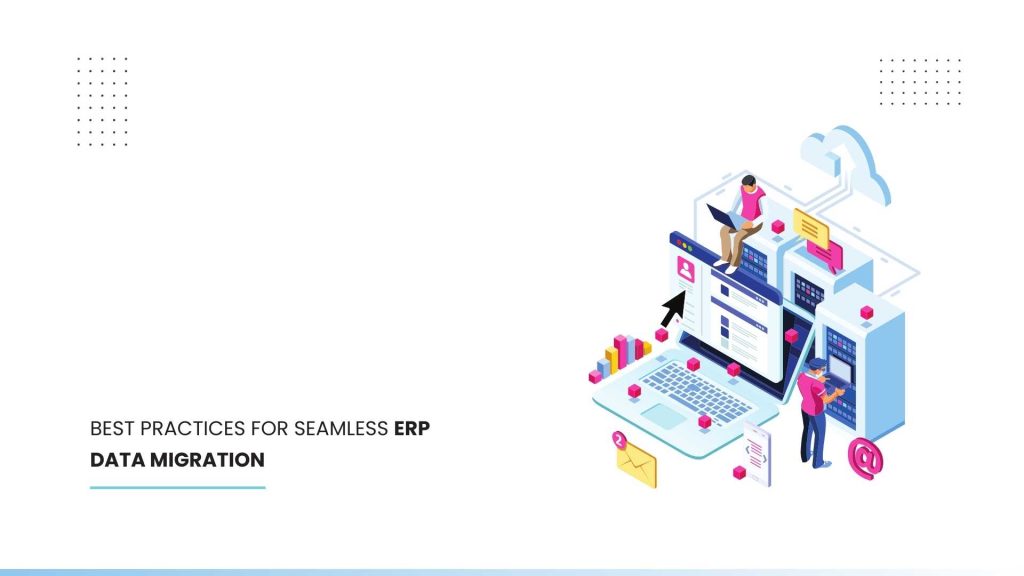Introducing the latest version of the ERP system is important to every organization. This step is vital for data migration, which entails moving current data from old systems to the latest ERP platform.
While data migration can be intricate and demanding, organizations can achieve a seamless and effective transition through careful planning and following best practices.
Let’s delve into the best practices for ERP data migration to assist organizations in reducing risks, minimizing interruptions, and optimizing the benefits of their new ERP system.
Define Clear Migration Goals and Objectives
Representing precise goals and objectives is required before starting the ERP data migration process. Identify the data that must be migrated, such as important business details, historical records, and customer information.
Establish achievable timelines and allocate resources appropriately to be well-prepared for the migration. A well-defined plan and a thorough grasp of the desired results will steer the migration process and ensure it aligns with business objectives.
Assess and Cleanse Data
Ensuring Data Quality for a Successful ERP Implementation. Start by thoroughly evaluating current data and pinpointing inconsistencies, duplicates, or inaccuracies. Please take the necessary steps to cleanse and standardize the data, aligning it with the new ERP system’s specifications.
Introduce data validation protocols and cleansing methods to maintain the accuracy and integrity of the migrated data. This crucial process will mitigate potential problems and establish a robust base for seamless operations within the new ERP framework.
Develop a Robust Data Migration Strategy
Crafting a well-defined data migration strategy is essential to guarantee a smooth transition. Choosing the best migration approach – direct, phased, or parallel run – is important based on data volume, system complexity, and resource availability.
Data mapping and transformation rules should also be set up to match legacy data structures with the new ERP system. A comprehensive strategy will aid in risk management, ensuring data consistency and reducing disruptions throughout the migration process.
Conduct Data Testing and Validation
Testing and Validation Importance in Data Migration
- Testing and validation are essential in providing the integrity and accuracy of migrated data.
- Create test scenarios and conduct end-to-end testing to ensure data integrity and functionality in the new ERP system.
- Perform data reconciliation exercises to maintain data consistency between the old and new systems.
- Engage key stakeholders in the testing phase for feedback and proactive issue resolution.
- Thorough testing and validation help reduce risks and build trust in the migrated data.
Train and Support End Users:
User Training and Support for Successful ERP Data Migration
- Deliver thorough training to end users to ensure a smooth ERP data migration process.
- Provide a comprehensive understanding of the new ERP system, its features, and how to effectively use the migrated data.
- Create training resources, host workshops, and offer continuous support to address user queries and encourage engagement.
- Empowering users with knowledge will enhance the new ERP system’s advantages and operational efficiency.
Monitor and Optimize Data Performance:
After completing data migration, it is crucial to consistently monitor and enhance data performance in the ERP system. It involves setting up data performance metrics, overseeing data quality, and promptly resolving data-related issues.
Regularly assess and improve data processes and workflows to meet business needs. Monitor system performance and gather user feedback to pinpoint areas for enhancement and optimize data utilization.
Establish Data Monitoring:
Data governance and security must be top priorities during the data migration phase. It is crucial to set data access controls and enforce strong security measures to safeguard sensitive information during the migration.
Develop data governance policies and procedures to uphold data privacy, quality, and compliance with applicable regulations. A clearly outlined data governance framework will guarantee the integrity and security of data within the ERP system.
Conclusion
Navigating the intricacies of data migration during a cloud ERP implementation can be daunting. However, Acumatica‘s meticulous data migration plan offers a structured and thorough approach, ensuring a smoother transition.
Acumatica facilitates a streamlined process by prioritizing organization and detail, empowering businesses to confidently harness the full benefits of their ERP system.
Read Related Blog: Understanding ERP Data Migration

Vijay comes with a vast experience in ERP and enterprise solutions space with about 20 years of experience in various packaged application like Acumatica, SAP, Orion, Salesforce.com, SugarCRM and, SalesLogix.

